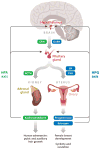Perinatal environmental exposures affect mammary development, function, and cancer risk in adulthood
- PMID: 22017681
- PMCID: PMC3477544
- DOI: 10.1146/annurev-pharmtox-010611-134659
Perinatal environmental exposures affect mammary development, function, and cancer risk in adulthood
Abstract
Puberty is an important transition that enables reproduction of mammalian species. Precocious puberty, specifically early thelarche (the appearance of breast "buds"), in girls of multiple ethnic backgrounds is a major health problem in the United States and other countries. The cause for a continued decrease in the age of breast development in girls is unknown, but environmental factors likely play a major role. Laboratory and epidemiological studies have identified several individual environmental factors that affect breast development, but further progress is needed. Current research needs include increased attention to and recording of prenatal and neonatal environmental exposures, testing of marketed chemicals for effects on the mammary gland, and understanding of the mammary gland-specific mechanisms that are altered by chemicals. Such research is required to halt the increasing trend toward puberty at earlier ages.
Figures


Similar articles
-
Prenatal and childhood exposure to endocrine-disrupting chemicals and early thelarche in 8-year-old girls: A prospective study using Bayesian kernel regression.Environ Res. 2024 Dec 15;263(Pt 1):120056. doi: 10.1016/j.envres.2024.120056. Epub 2024 Sep 27. Environ Res. 2024. PMID: 39343343
-
Endocrine-disrupting compounds and mammary gland development: early exposure and later life consequences.Endocrinology. 2006 Jun;147(6 Suppl):S18-24. doi: 10.1210/en.2005-1131. Epub 2006 May 11. Endocrinology. 2006. PMID: 16690811 Review.
-
Hypothesis: exposure to endocrine-disrupting chemicals may interfere with timing of puberty.Int J Androl. 2010 Apr;33(2):346-59. doi: 10.1111/j.1365-2605.2010.01051.x. Int J Androl. 2010. PMID: 20487042 Review.
-
The Effect of Bisphenol A on Puberty: A Critical Review of the Medical Literature.Int J Environ Res Public Health. 2017 Sep 10;14(9):1044. doi: 10.3390/ijerph14091044. Int J Environ Res Public Health. 2017. PMID: 28891963 Free PMC article. Review.
-
Agricultural pesticides and precocious puberty.Vitam Horm. 2014;94:27-40. doi: 10.1016/B978-0-12-800095-3.00002-X. Vitam Horm. 2014. PMID: 24388186 Review.
Cited by
-
High AHR expression in breast tumors correlates with expression of genes from several signaling pathways namely inflammation and endogenous tryptophan metabolism.PLoS One. 2018 Jan 10;13(1):e0190619. doi: 10.1371/journal.pone.0190619. eCollection 2018. PLoS One. 2018. PMID: 29320557 Free PMC article.
-
Assessing Heavy Metal and PCB Exposure from Tap Water by Measuring Levels in Plasma from Sporadic Breast Cancer Patients, a Pilot Study.Int J Environ Res Public Health. 2015 Dec 9;12(12):15683-91. doi: 10.3390/ijerph121215013. Int J Environ Res Public Health. 2015. PMID: 26690196 Free PMC article.
-
State of the evidence 2017: an update on the connection between breast cancer and the environment.Environ Health. 2017 Sep 2;16(1):94. doi: 10.1186/s12940-017-0287-4. Environ Health. 2017. PMID: 28865460 Free PMC article. Review.
-
Perinatal Exposure to Bisphenol A or Diethylstilbestrol Increases the Susceptibility to Develop Mammary Gland Lesions After Estrogen Replacement Therapy in Middle-Aged Rats.Horm Cancer. 2017 Apr;8(2):78-89. doi: 10.1007/s12672-016-0282-1. Epub 2017 Jan 11. Horm Cancer. 2017. PMID: 28078498 Free PMC article.
-
Changes in mammary histology and transcriptome profiles by low-dose exposure to environmental phenols at critical windows of development.Environ Res. 2017 Jan;152:233-243. doi: 10.1016/j.envres.2016.10.021. Epub 2016 Oct 29. Environ Res. 2017. PMID: 27810681 Free PMC article.
References
-
- Ojeda SR, Roth C, Mungenast A, Heger S, Mastronardi C, et al. Neuroendocrine mechanisms controlling female puberty: new approaches, new concepts. Int J Androl. 2006;29:256–63. discussion 286–90. - PubMed
-
- Biro FM, McMahon RP, Striegel-Moore R, Crawford PB, Obarzanek E, et al. Impact of timing of pubertal maturation on growth in black and white female adolescents: The National Heart, Lung, and Blood Institute Growth and Health Study. J Pediatr. 2001;138:636–43. - PubMed
-
- Golub MS, Collman GW, Foster PM, Kimmel CA, Rajpert-De Meyts E, et al. Public health implications of altered puberty timing. Pediatrics. 2008;121(Suppl 3):S218–30. - PubMed
-
- Herman-Giddens ME, Slora EJ, Wasserman RC, Bourdony CJ, Bhapkar MV, et al. Secondary sexual characteristics and menses in young girls seen in office practice: a study from the Pediatric Research in Office Settings network. Pediatrics. 1997;99:505–12. - PubMed
-
- Euling SY, Selevan SG, Pescovitz OH, Skakkebaek NE. Role of environmental factors in the timing of puberty. Pediatrics. 2008;121(Suppl 3):S167–71. - PubMed
Publication types
MeSH terms
Substances
Grants and funding
LinkOut - more resources
Full Text Sources
Medical

